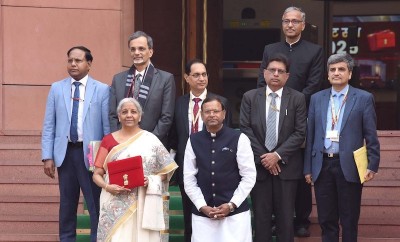
India must aim for 8% growth rate to surpass China: Barclays
New Delhi: For India to surpass China and emerge as the leading contributor to global growth, it would have to aim for an 8 percent growth rate, a Barclays report said.
The analysts at Barclays note that India has exhibited impressive growth, outpacing other nations, with strong expansion coupled with relatively modest inflation. The country is progressing towards achieving a minimum of 6 percent GDP growth while maintaining overall macroeconomic stability.
But a key question, the report says is whether authorities can "encourage more rapid growth without compromising India’s hard-won macro stability that has dominated India's growth ambitions since the start of the Ukraine-Russia war".
“Amid considerable economic turbulence in the rest of the world, India has been an island of relatively better macro outcomes in the past two years. On the surface, India is once again poised to be the fastest-growing major economy in the medium term, as global growth is expected to be weaker through 2023-2024 (compared to historical levels),” the report says.
The report notes that investment turnaround has been ‘remarkable’ and underscores that this transformation in India as an attractive destination for investment comes just 10 years after it was one of the so-called 'Fragile Five' economies where it was grappling with significant macro instability “in the form of a heavy debt burden, an unstable financial sector, and a weak fiscal profile, policy conditions.”
In 2023, although India's economic expansion has decelerated, it has outperformed other nations globally, maintaining a stable macroeconomic environment. The government is also dedicated to controlling inflation. Despite being the fastest growing prominent economy (excluding China) in the last ten years, India's contribution to the global GDP has stayed around 10 percent. Presently, India's share in the global economy is considerably less than both China and the United States.
While the report says that while India will “likely continue to outpace China on growth in the next five years under current growth projections (IMF), its contribution to global GDP will still lag.”
The report suggests that achieving this growth requires the government to establish several economic prerequisites. These include increasing the nominal savings rate to approximately 32.3 percent of GDP from the current 30.2 percent, and fostering an annual incremental growth in the workforce of 3.5 percent, compared to the current rate of 1 percent.
This, the report says, can be achieved through “increased female participation, a larger global export share and ongoing productive use of capital quantified as an ICOR of around 5".
According to the report, one of the drivers for this could be the investment cycle gaining traction. “Investment has typically been the main provider of delta moves for India's economic growth. While the investment ratio has declined since peaking in FY08, we think India is at a point in its growth cycle where additional investment should generate returns at a more productive pace,” the report stated.
While over the last few years, the investments from traditional sectors have taken a back seat and given way to other sectors such as telecommunications, digitisation, etc., the report suggests that capacity constraints emerging in these areas highlight the need for greater investment to return to traditional sectors.
The report, further, calls for more public investment to "drive the structural shift upwards in overall investment and push the GDP growth rate closer to 8 percent".
Support Our Journalism
We cannot do without you.. your contribution supports unbiased journalism
IBNS is not driven by any ism- not wokeism, not racism, not skewed secularism, not hyper right-wing or left liberal ideals, nor by any hardline religious beliefs or hyper nationalism. We want to serve you good old objective news, as they are. We do not judge or preach. We let people decide for themselves. We only try to present factual and well-sourced news.







